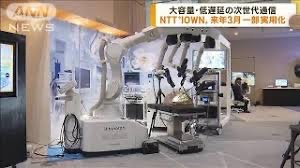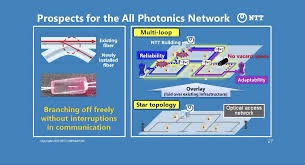

NTT’s IOWN: Delay is 1/200 of optical line!
– 1mm second delay in inter-site communication over 120km –
-IOWN 1.0 will start in March 2023-
NTT:
– NTT President Shimada Announces “IOWN Service” –
“IOWN” service:
The first “IOWN” service will start in March 2023.
NTT’s network
It is “IOWN (Innovative Optical and Wireless Network, Aion)”.
We aim to finalize the specifications in 2024 and realize it in 2030.
Release of IOWN1.0:
NTT President Shimada said in March 2023,
As the first step (IOWN1.0), we will provide APN service.
APN service:
ーCommunication service for corporations that connects two bases with a dedicated lineー
100 Gbps leased line service “Users end-to-end and monopolize optical wavelengths”
– What, the delay is 1/200 of the existing optical line –
“The delay in communication between bases 120 km away is 1 mm second,” he said.
It has a “delay adjustment function in units of 1 microsecond”.
Specific usage:
telemedicine,
smart factory,
It is expected to be used in e-sports.
For example, in esports, it will be possible to prevent delays that affect the outcome.
Development roadmap:
-Commercialization of IOWN2.0 service announced at Expo 2025 in Osaka, Kansai-
2023
Commercialization of network devices
2025
Plans to commercialize board connection devices
2029
Development of devices for chip-to-chip on board
2030
Utilization of “opticalization within the chip” as IOWN4.0
Investing in Rapidus:
The purpose of investing in Rapidus is “to utilize Rapidus’ next-generation XR device”
Versatile device:
In the future, a wide variety of devices will be required.
Semiconductor manufacturing that can handle that is also necessary.
In order to create high-speed chips for that purpose, it is best to support Japanese domestic vendors.
Next-generation optoelectronic convergence devices:
NTT has developed “photonic-based technology from transmission equipment to semiconductors”,
Efforts will be made to improve power consumption efficiency.
– Mobile Watch
https://k-tai.watch.impress.co.jp/docs/news/1455718.html
IOWN de NTT : Le délai est de 1/200 de la ligne optique !
– 1mm seconde de retard dans la communication inter-sites sur 120km –
-IOWN 1.0 débutera en mars 2023-
NTT :
– Le président de NTT, Shimada, annonce le “service IOWN” –
Service « IOWN » :
Le premier service « IOWN » démarrera en mars 2023.
Le réseau NTT
Il s’agit de “IOWN (Innovative Optical and Wireless Network, Aion)”.
Nous visons à finaliser le cahier des charges en 2024 et à le réaliser en 2030.
Sortie de IOWN1.0 :
Le président de NTT, Shimada, a déclaré en mars 2023,
Dans un premier temps (IOWN1.0), nous fournirons le service APN.
Service APN :
ーService de communication pour les entreprises qui relie deux bases avec une ligne dédiéeー
Service de ligne louée 100 Gbps “Les utilisateurs de bout en bout et monopolisent les longueurs d’onde optiques”
– Quoi, le retard est de 1/200 de la ligne optique existante –
“Le retard de communication entre les bases distantes de 120 km est de 1 mm seconde”, a-t-il déclaré.
Il a une “fonction de réglage du retard en unités de 1 microseconde”.
Utilisation spécifique :
télémédecine,
usine intelligente,
Il devrait être utilisé dans les sports électroniques.
Par exemple, dans les sports électroniques, il sera possible d’éviter les retards qui affectent le résultat.
Feuille de route de développement :
-Commercialisation du service IOWN2.0 annoncée à l’Expo 2025 à Osaka, Kansai-
2023
Commercialisation des équipements réseau
2025
Envisage de commercialiser des dispositifs de connexion au tableau
2029
Développement de dispositifs pour chip-to-chip à bord
2030
Utilisation de “l’opticalisation dans la puce” comme IOWN4.0
Investir dans Rapidus :
Le but d’investir dans Rapidus est “d’utiliser l’appareil XR de nouvelle génération de Rapidus”
Appareil polyvalent :
À l’avenir, une grande variété d’appareils sera nécessaire.
La fabrication de semi-conducteurs capables de gérer cela est également nécessaire.
Afin de créer des puces à grande vitesse à cette fin, il est préférable de soutenir les fournisseurs nationaux japonais.
Dispositifs de convergence optoélectronique de nouvelle génération :
NTT a développé “une technologie basée sur la photonique, des équipements de transmission aux semi-conducteurs”,
Des efforts seront faits pour améliorer l’efficacité de la consommation d’énergie.
– Montre mobile
IOWN von NTT: Die Verzögerung beträgt 1/200 der optischen Leitung!
– 1 mm Sekunde Verzögerung bei der Kommunikation zwischen Standorten über 120 km –
-IOWN 1.0 startet im März 2023-
NTT:
– NTT-Präsident Shimada kündigt „IOWN-Service“ an –
„IOWN“-Dienst:
Der erste „IOWN“-Dienst startet im März 2023.
NTTs Netzwerk
Es ist “IOWN (Innovatives optisches und drahtloses Netzwerk, Aion)”.
Wir streben an, die Spezifikationen im Jahr 2024 fertigzustellen und im Jahr 2030 umzusetzen.
Veröffentlichung von IOWN1.0:
NTT-Präsident Shimada sagte im März 2023:
Als ersten Schritt (IOWN1.0) werden wir den APN-Dienst bereitstellen.
APN-Dienst:
ーKommunikationsdienst für Unternehmen, der zwei Basen mit einer Standleitung verbindetー
100-Gbit/s-Standleitungsdienst „End-to-End-Nutzer und Monopolisierung optischer Wellenlängen“
– Was, die Verzögerung beträgt 1/200 der bestehenden optischen Leitung –
„Die Kommunikationsverzögerung zwischen 120 km entfernten Stützpunkten beträgt 1 mm Sekunde“, sagte er.
Es hat eine “Verzögerungsanpassungsfunktion in Einheiten von 1 Mikrosekunde”.
Spezifische Verwendung:
Telemedizin,
intelligente Fabrik,
Es soll im E-Sport zum Einsatz kommen.
Im Esport wird es beispielsweise möglich sein, Verzögerungen zu vermeiden, die sich auf das Ergebnis auswirken.
Entwicklungsfahrplan:
-Kommerzialisierung des IOWN2.0-Dienstes auf der Expo 2025 in Osaka, Kansai, angekündigt-
2023
Kommerzialisierung von Netzwerkgeräten
2025
Pläne zur Kommerzialisierung von Platinenverbindungsgeräten
2029
Entwicklung von Geräten für Chip-to-Chip an Bord
2030
Nutzung der „Optikalisierung im Chip“ als IOWN4.0
In Rapidus investieren:
Der Zweck der Investition in Rapidus besteht darin, „das XR-Gerät der nächsten Generation von Rapidus zu nutzen“.
Vielseitiges Gerät:
In Zukunft werden verschiedenste Geräte benötigt.
Auch eine Halbleiterfertigung, die damit umgehen kann, ist notwendig.
Um Hochgeschwindigkeitschips für diesen Zweck zu entwickeln, ist es am besten, japanische Inlandsanbieter zu unterstützen.
Optoelektronische Konvergenzgeräte der nächsten Generation:
NTT hat „Photonik-basierte Technologie von Übertragungsgeräten bis zu Halbleitern“ entwickelt,
Es werden Anstrengungen unternommen, um die Energieverbrauchseffizienz zu verbessern.
– Mobile Uhr
NTT planning launch of super-fast communication network
NHK WORLD-JAPAN News
NTT says it will soon launch a communications network
capable of handling huge volumes of data at very high speeds while using less electricity.
The next-generation network is called IOWN, which stands for “Innovative Optical and Wireless Network.
” It’s slated to go into limited practical use in Japan from March next year.
NTT President and CEO Shimada Akira unveiled the plan to the media.
The initial phase in March
will see a dedicated line service that will slash end-to-end latency to one 200ths of the current rate.
NTT President and CEO Shimada said, “It will be the first in the world to realize a network service with such a reduced latency.
We hope to see a variety of introduction cases in Japan, before looking at the next phase.”
The Japanese telecom giant
expects the service to be used for such purposes as remote medical care employing robots.
The company aims to increase transmission capacity by 125 times from fiscal 2030.
Ten-thousand full-length movies could be downloaded in the blink of an eye at such a speed.